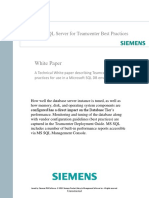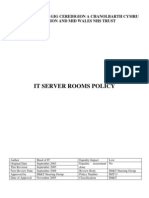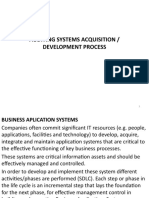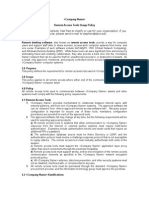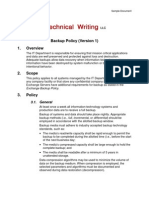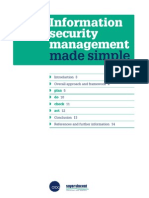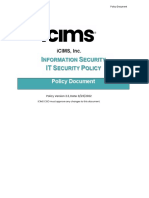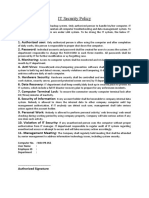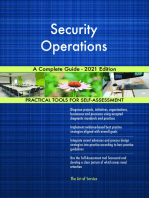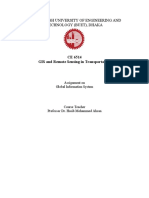Technology Equipment Disposal Policy
Technology Equipment Disposal Policy
Uploaded by
Junon ArmoryCopyright:
Available Formats
Technology Equipment Disposal Policy
Technology Equipment Disposal Policy
Uploaded by
Junon ArmoryOriginal Description:
Copyright
Available Formats
Share this document
Did you find this document useful?
Is this content inappropriate?
Copyright:
Available Formats
Technology Equipment Disposal Policy
Technology Equipment Disposal Policy
Uploaded by
Junon ArmoryCopyright:
Available Formats
Consensus Policy Resource Community
Technology Equipment Disposal Policy
Free Use Disclaimer: This policy was created by or for the SANS Institute for the
Internet community. All or parts of this policy can be freely used for your organization.
There is no prior approval required. If you would like to contribute a new policy or
updated version of this policy, please send email to policy-resources@sans.org.
Last Update Status: Updated June 2014
1. Overview
Technology equipment often contains parts which cannot simply be thrown away. Proper
disposal of equipment is both environmentally responsible and often required by law. In
addition, hard drives, USB drives, CD-ROMs and other storage media contain various kinds of
<Company Name> data, some of which is considered sensitive. In order to protect our
constituent’s data, all storage mediums must be properly erased before being disposed of.
However, simply deleting or even formatting data is not considered sufficient. When deleting
files or formatting a device, data is marked for deletion, but is still accessible until being
overwritten by a new file. Therefore, special tools must be used to securely erase data prior to
equipment disposal.
2. Purpose
The purpose of this policy it to define the guidelines for the disposal of technology equipment
and components owned by <Company Name>.
3. Scope
This policy applies to any computer/technology equipment or peripheral devices that are no
longer needed within <Company Name> including, but not limited to the following: personal
computers, servers, hard drives, laptops, mainframes, smart phones, or handheld computers ( i.e.,
Windows Mobile, iOS or Android-based devices), peripherals (i.e., keyboards, mice, speakers),
printers, scanners, typewriters, compact and floppy discs, portable storage devices (i.e., USB
drives), backup tapes, printed materials.
All <Company Name> employees and affiliates must comply with this policy.
4. Policy
4.1 Technology Equipment Disposal
4.1.1 When Technology assets have reached the end of their useful life they should be sent to
the <Equipment Disposal Team> office for proper disposal.
4.1.2 The <Equipment Disposal Team> will securely erase all storage mediums in accordance
with current industry best practices.
SANS Institute 2014 – All Rights Reserved Page 1
Consensus Policy Resource Community
4.1.3 All data including, all files and licensed software shall be removed from equipment using
disk sanitizing software that cleans the media overwriting each and every disk sector of
the machine with zero-filled blocks, meeting Department of Defense standards.
4.1.4 No computer or technology equipment may be sold to any individual other than through
the processes identified in this policy (Section 4.2 below).
4.1.5 No computer equipment should be disposed of via skips, dumps, landfill etc. Electronic
recycling bins may be periodically placed in locations around <Company Name>. These
can be used to dispose of equipment. The <Equipment Disposal Team> will properly
remove all data prior to final disposal.
4.1.6 All electronic drives must be degaussed or overwritten with a commercially available
disk cleaning program. Hard drives may also be removed and rendered unreadable
(drilling, crushing or other demolition methods).
4.1.7 Computer Equipment refers to desktop, laptop, tablet or netbook computers, printers,
copiers, monitors, servers, handheld devices, telephones, cell phones, disc drives or any
storage device, network switches, routers, wireless access points, batteries, backup tapes,
etc.
4.1.8 The <Equipment Disposal Team> will place a sticker on the equipment case indicating
the disk wipe has been performed. The sticker will include the date and the initials of the
technician who performed the disk wipe.
4.1.9 Technology equipment with non-functioning memory or storage technology will have the
memory or storage device removed and it will be physically destroyed.
4.2 Employee Purchase of Disposed Equipment
4.2.1 Equipment which is working, but reached the end of its useful life to <Company Name>,
will be made available for purchase by employees.
4.2.2 A lottery system will be used to determine who has the opportunity to purchase available
equipment.
4.2.3 All equipment purchases must go through the lottery process. Employees cannot
purchase their office computer directly or “reserve” a system. This ensures that all
employees have an equal chance of obtaining equipment.
4.2.4 Finance and Information Technology will determine an appropriate cost for each item.
4.2.5 All purchases are final. No warranty or support will be provided with any equipment
sold.
4.2.6 Any equipment not in working order or remaining from the lottery process will be
donated or disposed of according to current environmental guidelines. Information
SANS Institute 2014 – All Rights Reserved Page 2
Consensus Policy Resource Community
4.2.7 Technology has contracted with several organizations to donate or properly dispose of
outdated technology assets.
4.2.8 Prior to leaving <Company Name> premises, all equipment must be removed from the
Information Technology inventory system.
5. Policy Compliance
5.1 Compliance Measurement
The Infosec team will verify compliance to this policy through various methods, including but
not limited to, business tool reports, internal and external audits, and feedback to the policy
owner.
5.2 Exceptions
Any exception to the policy must be approved by the Infosec Team in advance.
5.3 Non-Compliance
An employee found to have violated this policy may be subject to disciplinary action, up to and
including termination of employment.
6 Related Standards, Policies and Processes
None.
7 Definitions and Terms
None.
8 Revision History
Date of Change Responsible Summary of Change
June 2014 SANS Policy Team Updated and converted to new format.
SANS Institute 2014 – All Rights Reserved Page 3
You might also like
- Axos - r21x - Turn-Up Calix Turn UpDocument404 pagesAxos - r21x - Turn-Up Calix Turn Uprico orense100% (2)
- SQL Server For Teamcenter Best Practices 1.4Document33 pagesSQL Server For Teamcenter Best Practices 1.4Jeferson GevinskiNo ratings yet
- ELEC 3300 Introduction To Embedded Systems: Course Introduction Prof. Vinod PrasadDocument34 pagesELEC 3300 Introduction To Embedded Systems: Course Introduction Prof. Vinod PrasadKeith wongNo ratings yet
- Iso 17799 Security Audit Example PWCDocument26 pagesIso 17799 Security Audit Example PWCMancamiaicuruNo ratings yet
- Password PolicyDocument4 pagesPassword Policynoorulathar100% (2)
- Server Room PolicyDocument4 pagesServer Room PolicyShivam Sahani100% (1)
- Data Backup PolicyDocument11 pagesData Backup PolicyOmar Carrillo Quiros50% (2)
- GL - Cotact With Special Interest Group - Guidelines - DraftDocument8 pagesGL - Cotact With Special Interest Group - Guidelines - DraftEugen GraurNo ratings yet
- Ebook Top Five High Impact UseCases For Big Data Analytics PDFDocument20 pagesEbook Top Five High Impact UseCases For Big Data Analytics PDFProton ChaosrikulNo ratings yet
- State of Vermont: Backup PolicyDocument5 pagesState of Vermont: Backup PolicyzombieattackNo ratings yet
- Information Security Policy A Complete Guide - 2019 EditionFrom EverandInformation Security Policy A Complete Guide - 2019 EditionNo ratings yet
- SDR Kirvan DR Policy TemplateDocument2 pagesSDR Kirvan DR Policy TemplateHumberto BellidoNo ratings yet
- ICT Security PolicyDocument38 pagesICT Security PolicymaolewiNo ratings yet
- Byod PolicyDocument1 pageByod Policyapi-231740456No ratings yet
- Example Back Up PolicyDocument11 pagesExample Back Up PolicyGayathri Sharma100% (1)
- Information Technology PolicyDocument9 pagesInformation Technology PolicyfanoustNo ratings yet
- It Policy PDFDocument53 pagesIt Policy PDFgr8jobs nigeriaNo ratings yet
- IT Incident ManagementDocument3 pagesIT Incident ManagementAinura SakpireyevaNo ratings yet
- IT Policies-Asset Classification and Control PolicyDocument5 pagesIT Policies-Asset Classification and Control Policyrajagopalansankar0% (1)
- Data Center Infrastructure, Storage-Design Guide - SAN Distance Extension Using ISLs - Brocade Community Forums - 36627Document11 pagesData Center Infrastructure, Storage-Design Guide - SAN Distance Extension Using ISLs - Brocade Community Forums - 36627pom9gayNo ratings yet
- What Is NESA Compliance - ValueMentorDocument5 pagesWhat Is NESA Compliance - ValueMentorSachin RatnakarNo ratings yet
- TOC of IT DepartmentDocument5 pagesTOC of IT Departmentitsmesathish2023No ratings yet
- Disaster Recovery PolicyDocument21 pagesDisaster Recovery PolicyLavhonte Antonio Davis50% (2)
- IT SecurityDocument8 pagesIT Securitysyafei082No ratings yet
- HPH Framework Implementation GuidanceDocument112 pagesHPH Framework Implementation GuidanceAnil KumarNo ratings yet
- Information Technology Policy and ProceduresDocument15 pagesInformation Technology Policy and ProceduresNate Nyamasvisva100% (2)
- DRAFT Audit Logging and Monitoring PolicyDocument3 pagesDRAFT Audit Logging and Monitoring PolicyhughNo ratings yet
- Backup Recovery PolicyDocument4 pagesBackup Recovery PolicyBruno GuimarãesNo ratings yet
- Information Technology Procedure and Policy Manual: Verified by Approved byDocument14 pagesInformation Technology Procedure and Policy Manual: Verified by Approved bySarras InfoNo ratings yet
- Template - Access Control Policy Eg1Document2 pagesTemplate - Access Control Policy Eg1bedorlehacker100% (1)
- 08 - IT AUDIT CISA-System DevelopmentDocument38 pages08 - IT AUDIT CISA-System DevelopmentHamza NaeemNo ratings yet
- Security Incident Management ProcessDocument8 pagesSecurity Incident Management ProcessHiren DhadukNo ratings yet
- Lidget Green Primary School and Children's Centre Acceptable Use PolicyDocument4 pagesLidget Green Primary School and Children's Centre Acceptable Use Policybarbara.feather3403No ratings yet
- Remote Access Tools PolicyDocument2 pagesRemote Access Tools Policythanhtam3819100% (1)
- Backup PolicyDocument3 pagesBackup PolicypeacebabatundeNo ratings yet
- EDRM Security Questionnaire 1.1Document39 pagesEDRM Security Questionnaire 1.1olufunso akinsanya100% (1)
- Cyber Security Checklist - DatacentersDocument20 pagesCyber Security Checklist - DatacentersAldimiro SilvaNo ratings yet
- It Security PolicyDocument9 pagesIt Security PolicystrokenfilledNo ratings yet
- Operational Technology Security A Complete Guide - 2019 EditionFrom EverandOperational Technology Security A Complete Guide - 2019 EditionNo ratings yet
- Information Security Policy TemplateDocument4 pagesInformation Security Policy TemplateAnonymous ZWDQ57TNo ratings yet
- 6 BCP-DCPDocument19 pages6 BCP-DCPWriter CourseNo ratings yet
- Policy Document IT Access Policy: (Date)Document10 pagesPolicy Document IT Access Policy: (Date)bedorlehackerNo ratings yet
- 1.07 Secure Data Center Access PolicyDocument4 pages1.07 Secure Data Center Access PolicyGading AjiNo ratings yet
- RISK ASSESSMENT FOR IT TemplateDocument8 pagesRISK ASSESSMENT FOR IT Templatejenito215402No ratings yet
- IT Continuity, Backup and Recovery PolicyDocument8 pagesIT Continuity, Backup and Recovery PolicynaveedNo ratings yet
- ISO 27001-2013 ISMS Policy PDFDocument6 pagesISO 27001-2013 ISMS Policy PDFSunil AroraNo ratings yet
- Information Security Made SimpleDocument15 pagesInformation Security Made SimpleSeenivasagam Seenu50% (2)
- VPN Access Policy V 1.1Document10 pagesVPN Access Policy V 1.1Birhan100% (1)
- Information Security in Healthcare System - 26.12.14 - 10Document12 pagesInformation Security in Healthcare System - 26.12.14 - 10Shubham GoelNo ratings yet
- ISO 20000 OverviewDocument0 pagesISO 20000 OverviewNitish GoyalNo ratings yet
- Email Security PolicyDocument3 pagesEmail Security PolicycroslutNo ratings yet
- IT Security Policy 6SEPTEMBER2021Document39 pagesIT Security Policy 6SEPTEMBER2021Ilham ArdiansyahNo ratings yet
- Information Security Physical and Environmental Security Procedure PDFDocument10 pagesInformation Security Physical and Environmental Security Procedure PDFkumusha123No ratings yet
- Utilities Information Technology Physical Security Policy 987Document5 pagesUtilities Information Technology Physical Security Policy 987ncyuwptvNo ratings yet
- Cyber Security PolicyDocument16 pagesCyber Security PolicyPermanapurba100% (1)
- IT Security PoliciesDocument10 pagesIT Security Policiesapexauditsystem67% (3)
- TOR Records Management Consultancy Sept 2014Document4 pagesTOR Records Management Consultancy Sept 20144dev22No ratings yet
- 1 - Acceptable Usage Policy (00000002)Document15 pages1 - Acceptable Usage Policy (00000002)Shailkh YabaaNo ratings yet
- System Security PlanDocument11 pagesSystem Security PlanDhamoNo ratings yet
- It PoliciesDocument61 pagesIt PoliciesAdi ApriadiNo ratings yet
- Remote Access PolicyDocument3 pagesRemote Access PolicyRodoljub KajganicNo ratings yet
- IT Security Policy: 1. Authorized User: 2. PasswordDocument1 pageIT Security Policy: 1. Authorized User: 2. Passwordfahim faisalNo ratings yet
- El Mundo Es Tuyo Pero Tienes Que Ganartelo Descargar GratisDocument4 pagesEl Mundo Es Tuyo Pero Tienes Que Ganartelo Descargar GratisYohoysi GomezNo ratings yet
- Synopsis Online MatrimonialDocument21 pagesSynopsis Online MatrimonialRaj BangaloreNo ratings yet
- Week 02 - Algorithm Complexity - Design Analysis of AlgorithmDocument14 pagesWeek 02 - Algorithm Complexity - Design Analysis of AlgorithmMuhammad AfaqNo ratings yet
- Okidata MICROLINE ML3410 Service ManualDocument186 pagesOkidata MICROLINE ML3410 Service ManualMario FerrariNo ratings yet
- HIT Pendulum Impact TestersDocument24 pagesHIT Pendulum Impact TestersErisell CastilloNo ratings yet
- LinkedIn GuideDocument52 pagesLinkedIn GuideMiles100% (3)
- Huawei E3131 - USB MODEM To Access Data & Internet Through WirelessDocument9 pagesHuawei E3131 - USB MODEM To Access Data & Internet Through Wirelessvkannan07666No ratings yet
- Internet of Things Based Smart Vending Machine Using Digital Payment SystemDocument14 pagesInternet of Things Based Smart Vending Machine Using Digital Payment SystemPAUL THOMAS 2127308No ratings yet
- Data Structures Algorithms and Applications in C by Sartraj SahaniDocument826 pagesData Structures Algorithms and Applications in C by Sartraj SahaniMohammed Nassf100% (1)
- Simple, Beautiful Notes For Ableton Live: Getting Started GuideDocument10 pagesSimple, Beautiful Notes For Ableton Live: Getting Started GuideClément GillauxNo ratings yet
- STQA Assignment 3 RutujaDocument9 pagesSTQA Assignment 3 RutujaRutuja GuravNo ratings yet
- FM Read - TextDocument3 pagesFM Read - Textedmondo77No ratings yet
- Final Project CSC 425Document8 pagesFinal Project CSC 425Nurul Atikah Shahrul EffendiNo ratings yet
- DBS10219-13 DM800 - Installation ManualDocument75 pagesDBS10219-13 DM800 - Installation ManualnzmrsNo ratings yet
- SX32e OM PDFDocument38 pagesSX32e OM PDFIrpan SusiloNo ratings yet
- Assignment 1 It Class BbaDocument7 pagesAssignment 1 It Class BbaHamZa Altaf HussainNo ratings yet
- Commanality ChartDocument34 pagesCommanality ChartRajan MullappillyNo ratings yet
- Enhancement of Supermarket Using Smart Trolley: International Journal of Computer Applications January 2021Document7 pagesEnhancement of Supermarket Using Smart Trolley: International Journal of Computer Applications January 2021Technical AkashNo ratings yet
- Qa Lead ResumeDocument8 pagesQa Lead Resumeafjwfealtsielb67% (3)
- b4b0 09Document98 pagesb4b0 09Sherif GamalNo ratings yet
- GIS&BlockchainDocument38 pagesGIS&Blockchainsrini100% (3)
- Cambridge International General Certificate of Secondary EducationDocument12 pagesCambridge International General Certificate of Secondary EducationMudassir KhanNo ratings yet
- Bangladesh University of Engineering and Technology (Buet), DhakaDocument19 pagesBangladesh University of Engineering and Technology (Buet), DhakaRashedKhanNo ratings yet
- Causes For Tempdb Full - SQL ServerDocument4 pagesCauses For Tempdb Full - SQL Serverarunkumarco50% (2)
- The Research of The Possibilities and ApplicationDocument9 pagesThe Research of The Possibilities and ApplicationDeepak ChaharNo ratings yet
- Exercises695Clas SolutionDocument13 pagesExercises695Clas SolutionHunAina Irshad100% (2)

